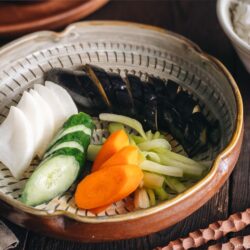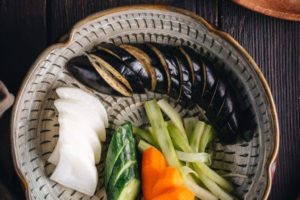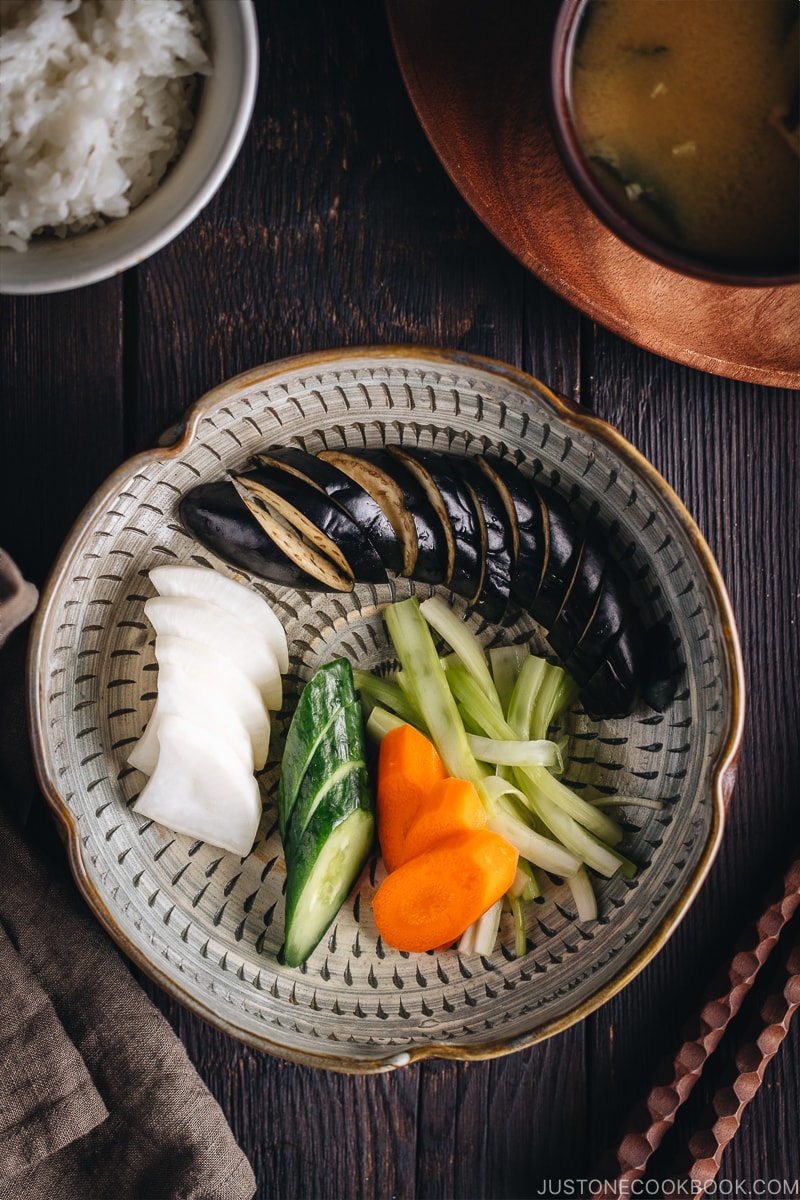
Shiozuke (塩漬け), literally salt (shio) + pickling (zuke), is the simplest Japanese pickle, known collectively as tsukemono (漬物). Salt pickles were first produced in ancient times as a means of preserving food, and over the years became an important part of the basic Japanese meal.
In this post, I’ll explain more about the different types of Japanese pickles. I’ll also teach you how to make delicious and refreshing Shiozuke at home.
What is Tsukemono?
Tsukemono (漬物), or Japanese pickles, are a classic side dish in a traditional Japanese meal. Some popular ones you may be familiar with include takuan (pickled daikon), umeboshi (pickled plum), gari (pickled sushi ginger), and fukujinzuke, the Japanese curry rice condiment.
Pickles are used to cleanse the palate between courses, such as pickled ginger in a sushi dinner. They help to preserve other foods, like a pickled plum tucked into a rice ball to help preserve the rice. Pickles that are crunchy also provide a textural contrast to any meal.
There are several types of tsukemono. Here are the different types and the pickling agent used:
- Shiozuke (塩漬け) – salt
- Suzuke (酢漬け) – vinegar
- Amazuzuke (甘酢漬け) – sugar and vinegar
- Misozuke (味噌漬け) – miso
- Shoyuzuke (醤油漬け) – soy sauce
- Kasuzuke (粕漬け) – sake kasu (lees)
- Shiokojizuke (塩麹) – rice koji (mold-cultured rice)
- Nukazuke (糠漬け) – nuka (rice bran)
- Karashizuke (からし漬け) – Japanese hot mustard karashi
- Satozuke (砂糖漬け) – sugar
Today, let’s talk about shiozuke. If you’re interested in learning more about different types of tsukemono, read Tsukemono: A Guide to Japanese Pickles on my blog.
What is Shiozuke?
Shiozuke (塩漬け) is tsukemono made with just salt and vegetables. Therefore, the amount of salt used for the brine and the pickling time make the difference in the final dish. When it’s done right, tsukemono is simply delicious.
Shiozuke not only prevents the food from going bad, but also helps break down the fibers, keeps the vibrant color, and tenderizes any tough vegetables that could be hard to eat raw. It also adds umami to the vegetables.
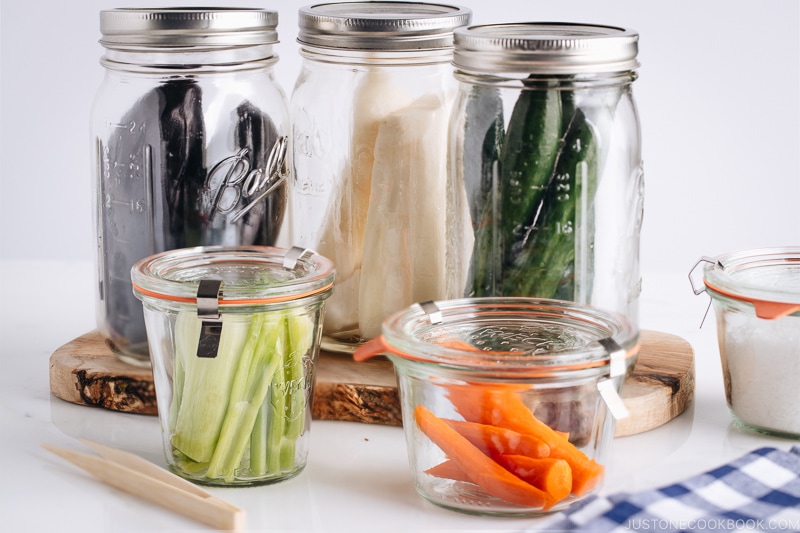
Basic Brine for Shiozuke
The basic brine that I learned from a tsukemono book, Honkaku Tsukemono written by a culinary & tsukemono expert Takako Yokoyama, is 10 percent. That means:
- 100 grams of sea salt in 1000 ml (grams) of water, or
- 6 tablespoons of sea salt (16 g per tbsp) for every 4 cups of water
In general, the percentage of salt in the water for shiozuke brine is from 2% to 10%. It’s quite a large range, but as I mentioned earlier, the amount of salt and pickle time is up to one’s preference. Today, I made my shiozuke with 5% brine and pickled it for 8 hours.
Asazuke vs. Shiozuke
When you pickle vegetables in a light brine for a short period of time, this method is called asazuke (浅漬け), literally “shallow pickling.” Asazuke doesn’t develop deep flavors that fermented pickles do, yet the result tastes wonderfully refreshing. Since it’s easy to make, asazuke frequently appears on our daily dinner table.
- shiozuke: 2% to 10% brine, pickle for 6 to 12 hours, enjoy in 3 to 4 days.
- asazuke (quick pickling): 2% to 5% brine, pickle for 2 to 3 hours, and enjoy in 1 to 2 days.
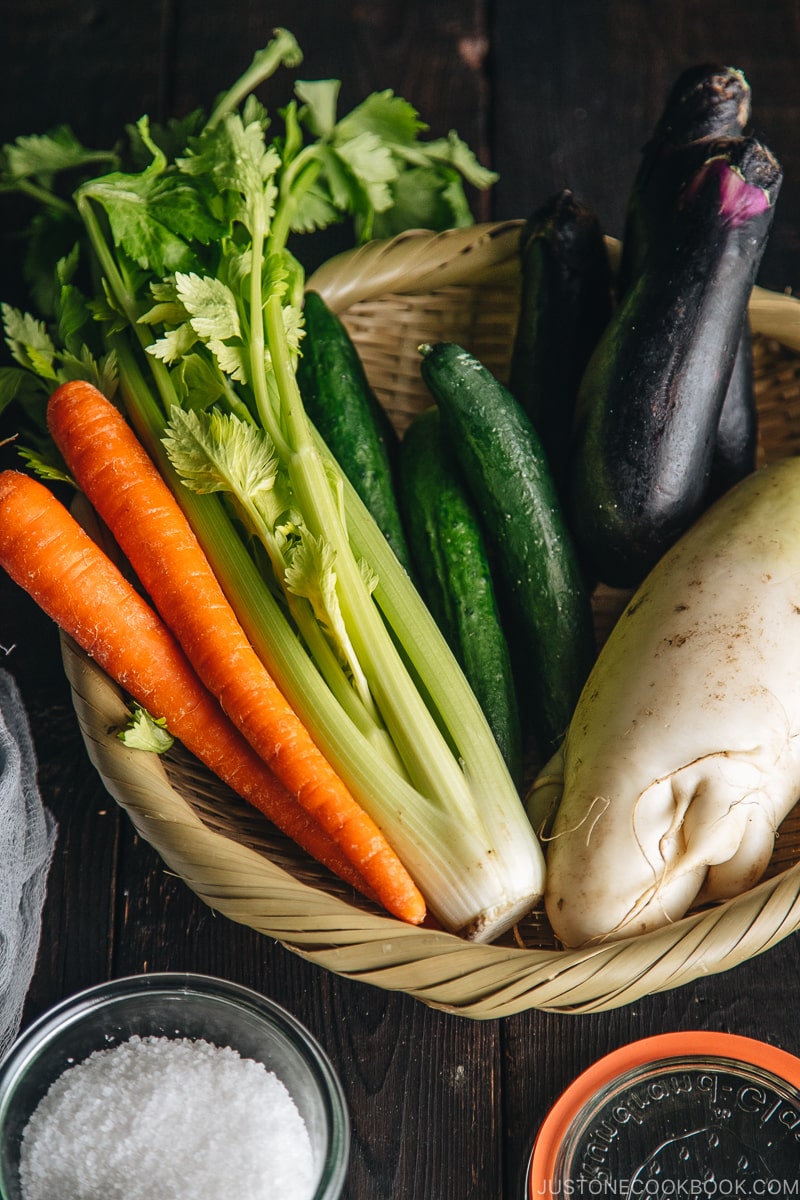
2 Simple Ingredients You’ll Need
1. Vegetables
The best choice is seasonal vegetables because they are fresh, easy to get, and at an affordable price. You can taste the freshness through the pickling process when you use fresh vegetables. Today, I used the common shiozuke vegetables:
- Eggplant – longer, thinner, and smaller; use the Japanese/Chinese/Italian kind
- Cucumber – short, skinny, and smaller; use the Japanese/Persian kind
- Daikon radish – green-top, long, thick; use the Japanese/Korean kind
- Carrot
- Celery
You can make shiozuke with a wide variety of vegetables. In this recipe, I made a colorful batch of shiozuke with the above 5 types of vegetables. You can, of course, choose to make it with less or more vegetables. For first-timers, I’d recommend following my pickling time indicated in the recipe, which is 8 hours, then you could adjust the brine and timing in your next batch.
If you want to pickle leafy vegetables (napa cabbage, cabbage, greens, etc.), I recommend asazuke (quick pickling) with 2–5% brine.
2. Salt
I like to go with the traditional method: Use natural sea salt when you make tsukemono, and do not use table salt.
Sea salt is produced through evaporation of ocean water or water from saltwater lakes, usually with little processing. This leaves behind certain trace minerals and elements, which add flavor and color to sea salt.
On the other hand, table salt is typically mined from underground salt deposits, is more heavily processed to eliminate minerals, and usually contains an additive to prevent clumping.
Additional Mix-ins (Optional)
In this recipe, I decided to keep it basic. However, we can make different variations of shiozuke using additional ingredients. You can include:
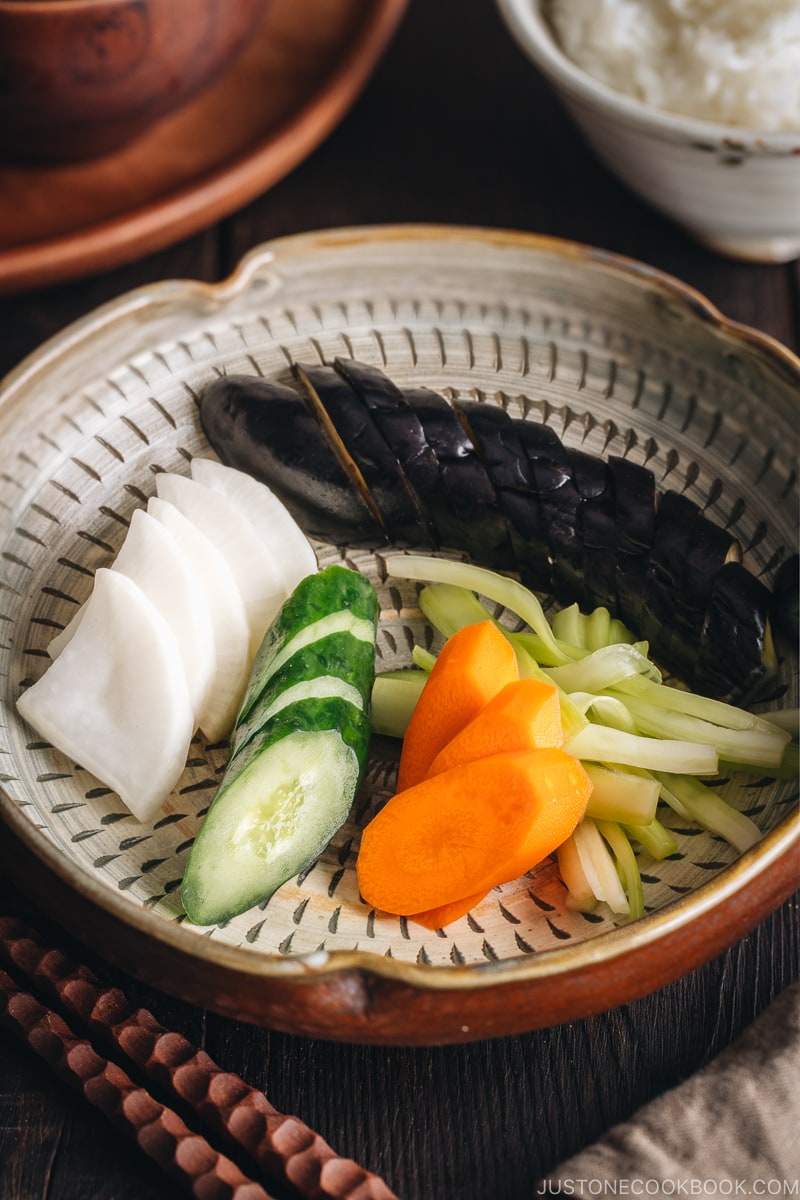
How to Make Shiozuke
- Decide how much sea salt to use and weigh the salt.
- Weigh each vegetable and write down the weight.
- Make the brine. Put the water and sea salt in a pot over medium heat until warm and the salt dissolves completely. You do not need to boil. Turn off the heat and let the mixture cool.
- Cut the vegetables, if necessary. Place in the pickling container.
- Pour the cooled brine over the vegetables until they are completely submerged.
- Place a plate and the weights on top. Place a lid on and close tightly.
- Set a timer for the pickling time. Remove the pickles promptly.
3 Tools You’ll Need to Make Shiozuke
1. Kitchen Scale
I understand that it’s not common to have a kitchen scale in the American household, but now that you want to make tsukemono, it’s very important to measure 1) the total weight of the vegetables you’re going to pickle, 2) the weight of sea salt, and 3) the heavy object you put on top of the vegetables.
The kitchen scale that I use in my recipes is from Amazon and I’ve had it for a long time. I usually use the gram measurement for my baking and other traditional Japanese recipes; therefore, I highly recommend getting one now if you like to follow recipes precisely.
2. Glass Containers
You will need slightly deeper containers with lids so you can put in the vegetables, brine, plates, and weights. Instead of plastic containers, I like to use glass containers that don’t retain the odor of the pickles. I do not have a special pickle press for tsukemono (tsukemono-ki 漬物器), but you can use it if you have one.
3. Weights (Stone Weights)
You will need something heavy to apply downward pressure on top of the pickles. You can use several plates, pie weights in a plastic bag, clean rocks, etc. Traditionally, the pressure is generated by heavy stones called tsukemono-ishi (漬物石) with a weight of 1–2 kg.
The ideal weight to use is between 1.5 and 2 times the weight of the pre-pickled vegetables. When using weights, make sure to:
- first weigh the vegetables before you soak them in the brine
- place a plate under the stone or heavy object inside the pickling container; this distributes the weight equally among the vegetables.
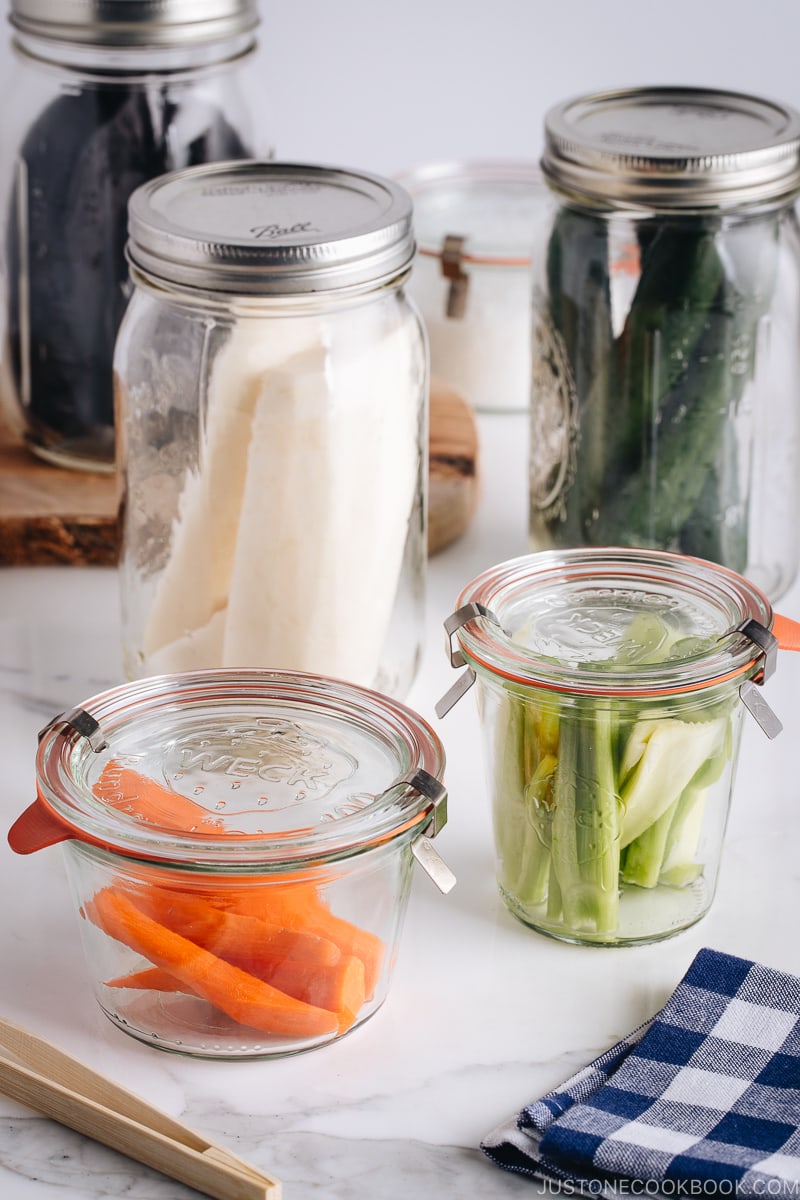
My Recommendations and Tips
- My favorite shiozuke: 5% brine, pickle for 8 hours, enjoy in 3–4 days; and 10% brine, pickle for 5 hours, enjoy for 5 days.
- Make asazuke (quick pickling) if you are going to serve tsukemono for tonight’s dinner.
- Again, get a kitchen scale.
- Decide to pickle either whole or sliced pieces. The way you cut the vegetables affects the finishing time and texture of the tsukemono. If you cut the vegetables to create more surface area, pickling is done faster than with whole, halved, or quartered vegetables.
- Reuse the leftover brine for your next pickling. Once in a while, it’s good to boil the brine again and add more salt as needed.
- Make the brine the previous day. The brine has to be at room temperature. When I first made shiozuke, I was impatient as my brine didn’t cool fast enough. In wintertime, you can keep the pot of brine outside to cool faster. In summertime, make the brine ahead of time, so you don’t have to sit around and wait for it to cool.
- Set a timer for removing the pickles from the brine. I sometimes forget and end up with salty vegetables!
What to Serve with Shiozuke
With a crunchy texture and refreshing flavor, shiozuke is definitely one of the easiest ways to enjoy vegetables. For a quick dinner, I often serve these pickled vegetables as a side with steamed rice and miso soup and I’d add along with a protein dish like Miso Butter Salmon or Ginger Pork. On a cold day, you can serve pickled vegetables with okayu (rice porridge). It could not be more simple, healthy, and full of flavor.
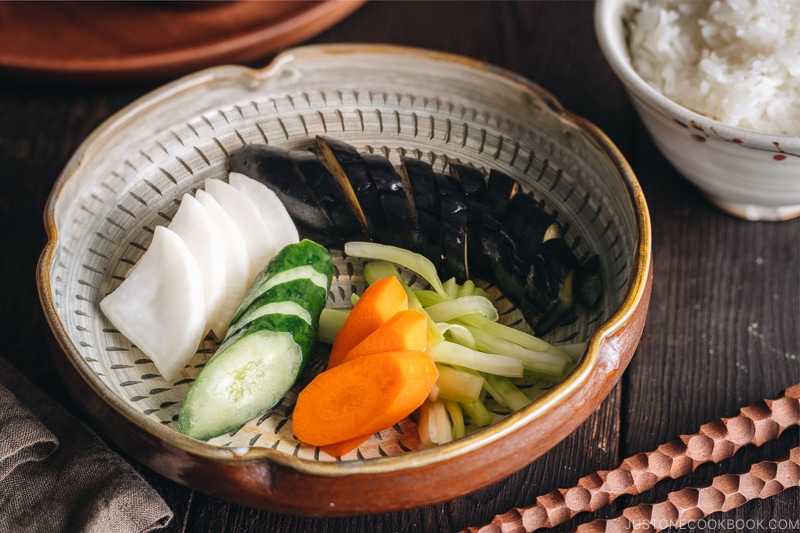
Wish to learn more about Japanese cooking? Sign up for our free newsletter to receive cooking tips & recipe updates! And stay in touch with me on Facebook, Pinterest, YouTube, and Instagram.
Tsukemono – Shiozuke (Salt Pickling)
Ingredients
For the Vegetables to Pickle
- 3 Japanese or Chinese eggplants (use Lucky Iron Fish to retain the color; see Notes)
- 5 Japanese or Persian cucumbers
- 1 daikon radish
- 5 ribs celery
- 2 carrots
For the Brine
- 1000 ml water
- 50 g sea salt (for 5% brine; you can use 2% to 10% salt in the brine)
Instructions
- Gather all the ingredients. Also, prepare a clean container with a lid for each vegetable. You can also put all vegetables (except for the eggplants) in one big container.
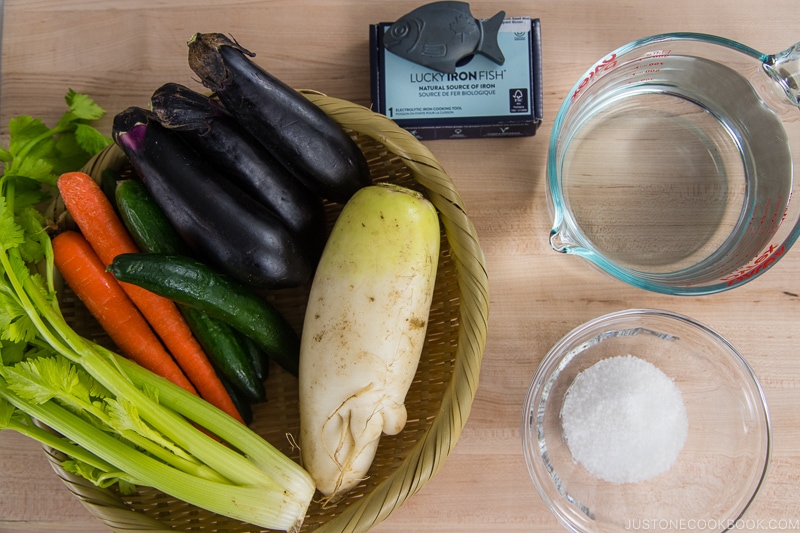
To Measure the Weight (Important!)
- Decide the amount of salt you want to use and weigh the salt. (Please read the blog post). This recipe is 5% brine (1000 ml water x 5% = 50 g sea salt). I made a double batch (100 g sea salt in 2000 ml water) as I used a lot of vegetables to demonstrate. You can use anywhere from 2% to 10% salt in the brine.
- Weigh each vegetable you’re pickling and write down the weights. At the next step, you‘ll need to find out the weight of the heavy objects to put on the vegetables.
- Figure out which heavy object to use. Make sure to include the plate that goes under the heavy object. The total weight (object + plate) needs to be 1.5 to 2 times of the total vegetable weight. You can use several plates, pie weights in a plastic bag, etc.
To Prepare the Brine
- Put 1000 ml water and 50 g sea salt in the pot. Let the salt dissolved completely over medium heat. You do not need to let it boil. You can turn off the heat once it’s warm and the salt is completely dissolved. Let cool. Tip: In winter, it’s fast if you put the pot outside (leaving the lid slightly ajar). In summer, make the brine the previous day.

To Cut the Vegetables (If Necessary)
- Eggplants: Cut off the end of 3 Japanese or Chinese eggplants. When you are making asazuke (quick pickles), cut the eggplant in half or cut a slit vertically about half the length in the eggplant to let the salt brine absorb. Otherwise, you don’t need to cut the eggplants. Place them in the container. Tip: To prevent the beautiful eggplants from discoloring, I used ‘Lucky Iron Fish‘ – a cooking tool that retains colors and adds iron to foods. It is optional but worth investing in, especially if you need more iron in your diet. You can purchase it on Amazon. I also use ‘Lucky Iron Fish‘ when I make Kuromame.
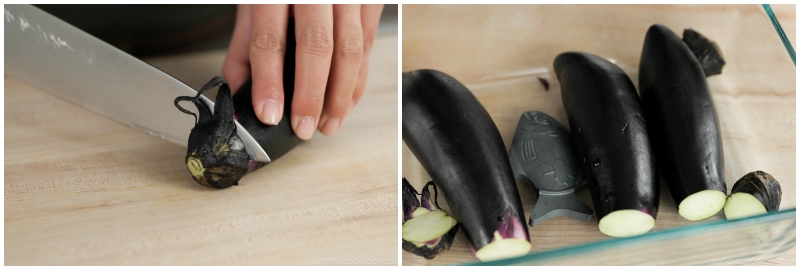
- Cucumbers: You don’t need to cut the 5 Japanese or Persian cucumbers. Place them in the container.
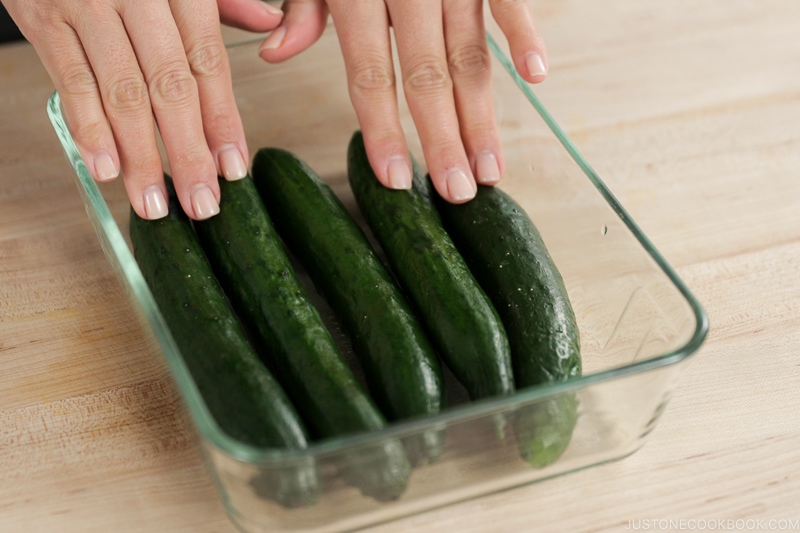
- Daikon radish: Peel and cut 1 daikon radish in half or quarters lengthwise depending on its size. Place them in the container.

- Celery: Remove the leafy parts of 5 ribs celery and cut into the length that will fit in the container. Place them in the container.

- Carrots: Peel and cut 2 carrots into the length that would fit in the container. Place them in the container.
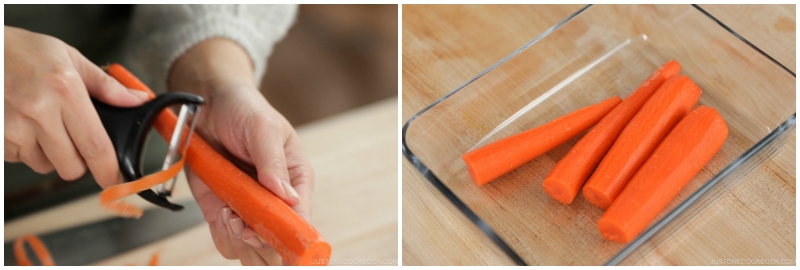
To Pickle the Vegetables
- Eggplants: Pour the brine until they are submerged.
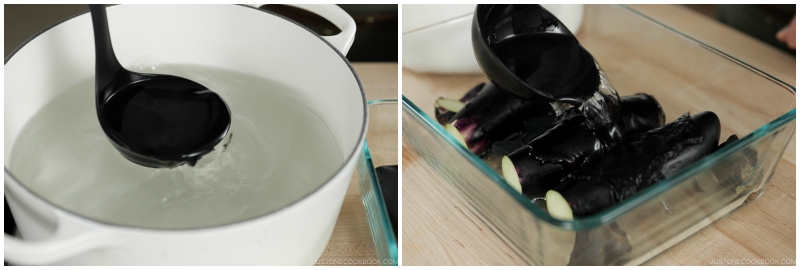
- Place a plate on top of the vegetable, and then put a weight on the plate. You can use plates and pie weights. Make sure the vegetables are completely submerged. Place a lid on and close tightly.

- Cucumbers: Pour the brine until they are submerged.
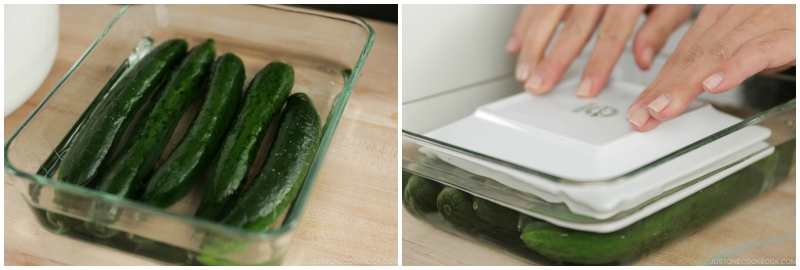
- Daikon radish: Pour the brine until they are submerged.

- Celeries: Pour the brine until they are submerged.
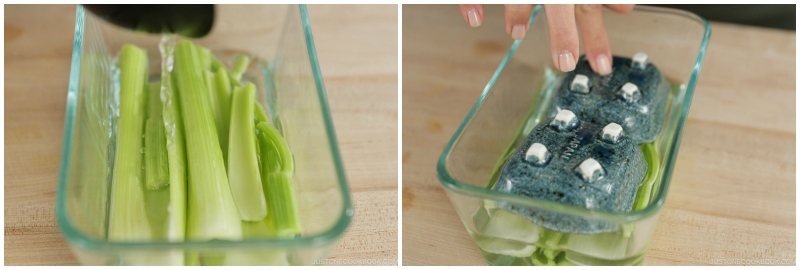
- Carrots: Pour the brine until they are submerged.
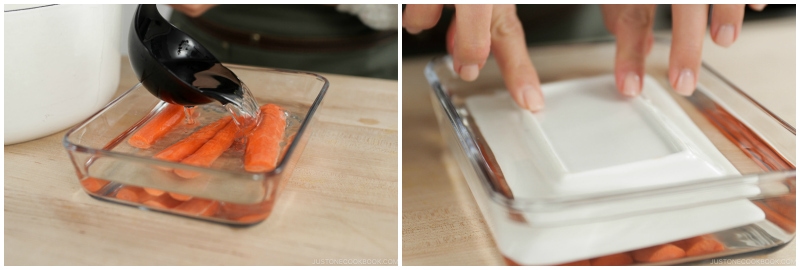
To Pickle
- Keep the tsukemono at room temperature for the best pickling. For my 5% brine, the best pickling time is 8 hours. Tip: You can adjust the pickling time according to your preference. Dense vegetable takes longer time to pickle than less dense vegetables. Please read the blog post.
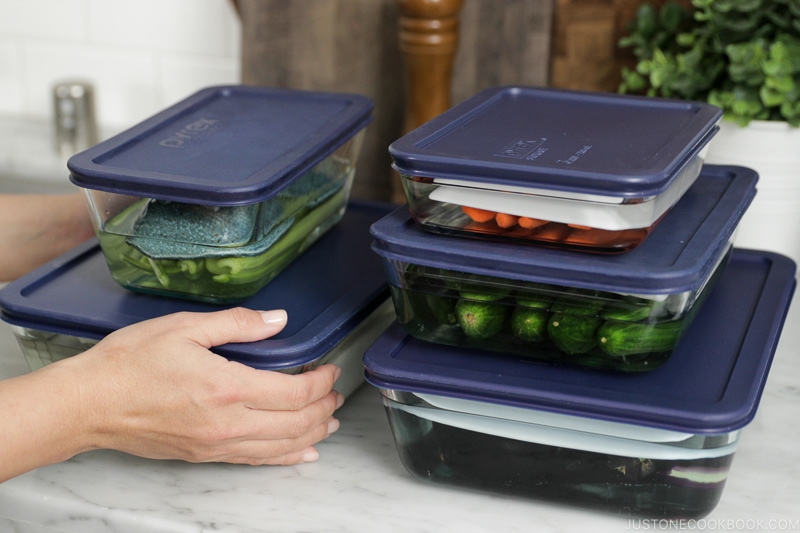
To Remove and Serve
- Remove the eggplants and Lucky Iron Fish from the brine and transfer to a clean airtight container or resealable plastic bag.
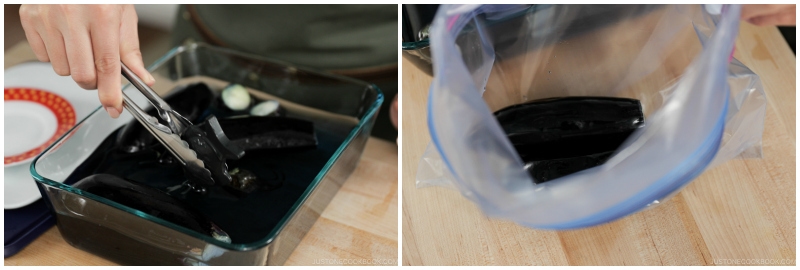
- Remove other vegetables from the brine and transfer to a clean airtight container.
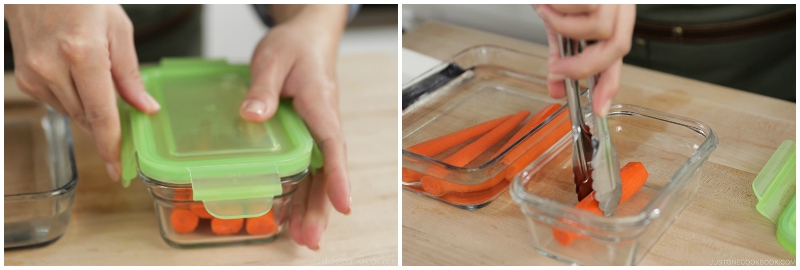
To Serve
- Cut the tsukemono into slices when you are ready to serve.

- Serve on a plate and enjoy!
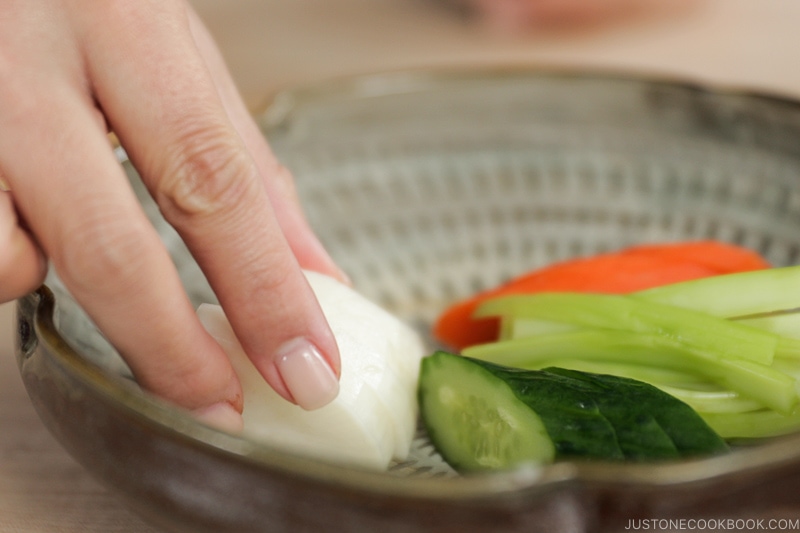
To Store
- With 5% brine, you can keep the shiozuke in the refrigerator for up to 4 days. Do not cut the tsukemono into slices until you are ready to serve.
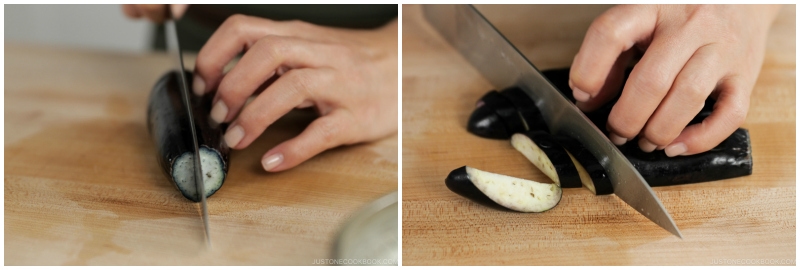
To Reuse of the Leftover Brine
- You can reuse the brine for up to a month. You may need to add more salt as the brine will become less salty. Also, it‘s good to boil the brine to keep it germ-free.
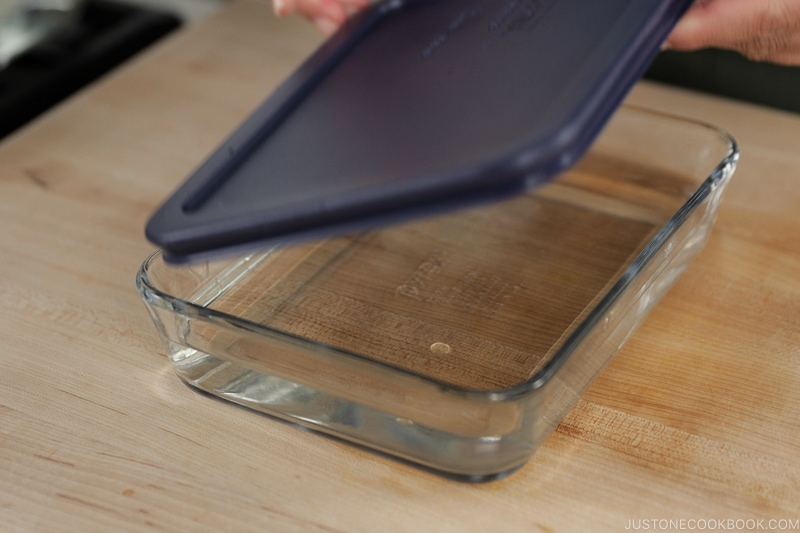
Notes
Nutrition
Did you make this recipe?
Tag @justonecookbook on Instagram so we can see your delicious creation!


